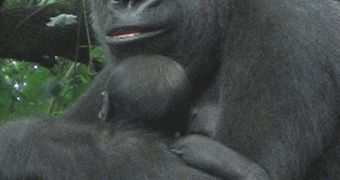The large primates, which are humans' closest relatives, also have the most elaborate system of communication other than our own. A new study, which surveyed gorilla populations in their natural habitat, may have found new clues as to how human language appeared and developed over time. Researchers have discovered the fact that the animals also learned to use quiet signals, that did not require the calling of a partner using screams, and that they only emitted these silent warnings when others were facing the emitter.
This is a crucial find, as it demonstrates that the apes are more than aware of the fact that the eyes are the optical receptors, and that they need to be turned in a specific direction in order for them to perceive something and incite a reaction from another ape.
Undoubtedly, millions of years ago, it was this kind of evolution that allowed humans to hunt silently, while at the same time coordinating their attacks. By using this technique, they learned to bring down prey several times their size and to cooperate for a mutually-beneficial goal.
"There has always been speculation that the origins of human language might lie in gesture, an idea supported by the close proximity of the brain areas involved in language and gesture. Many researchers have therefore studied the gestural communication of the great apes for clues to the evolutionary origins of human gesture," University of St Andrew School of Psychology professor Richard Byrne, who has been one of the leaders of the new study, says.
"But there is a persisting puzzle: each population seems to use a somewhat different repertoire of gestures, suggesting that individuals learn their gestures; yet there is no sign of local 'dialects' of gesture, group-specific gesture traditions, as would be expected if they learnt the gestures from each other," he adds.
"What we found was that, as we added more populations to the study, most gestures that had seemed specific to one individual or one site almost always turned up elsewhere. Any two populations are likely to differ a lot in the repertoire of gestures shown, but all are drawn from a very large, species-wide 'pool' of possible gestural signals," the scientist explains.
"So we think that, just as in the case of communicative gestures, the fact that apes have a huge repertoire of actions can explain how they imitate human demonstrations and why their copies are usually inexact: they are 're-using' actions from their own repertoire, not learning new ones," Byrne concludes.

 14 DAY TRIAL //
14 DAY TRIAL //